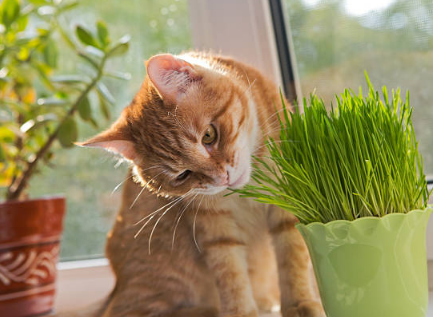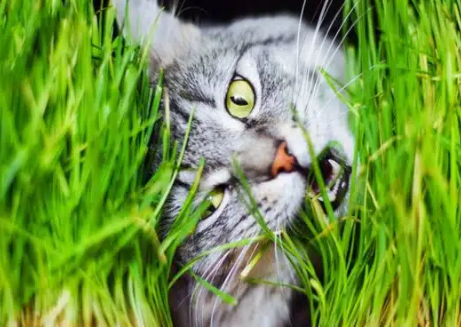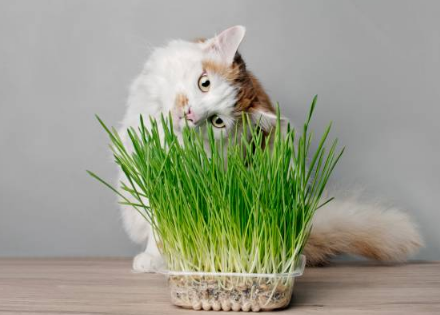We think cats are strict meat eaters, and that’s true. An adult cat’s diet should contain about 26%(animal-derived) protein, compared to 12% for dogs and 8% for humans. The protein consumed by dogs and humans does not necessarily come from animals, but in the case of cats, it must come from animals. While it is true that cats must eat meat for their health, they also occasionally eat plants, and eating grass is beneficial for cats. Let’s take a look at why cats love to eat grass and what benefits cat grass might have.

Reasons Why Cats Eat Grass
Scientists aren’t entirely sure why cats eat grass, but observations provide some valuable clues. Some believe that the ancestors of our domestic cats would have eaten grass after capturing their prey to induce vomiting or as a mild laxative. They may want to get rid of the indigestible parts of their prey. This is instinctive behavior, and even pets that have never caught a mouse may do so.
Another theory involves chlorophyll, a chemical component of chlorophyll. Studies have shown that the compound has anti-inflammatory and pain-relieving properties1. It seems plausible that cats may eat grass to play these roles. When you offer cat grass to your pet, they may do the same thing. After all, felines are able to hide their discomfort well and are better at managing it through other behaviors, such as purring.
One study considered these hypotheses in two surveys on domestic cats eating plants2. The researchers’ findings refute the hypothesis that felines eat plants only because they are sick, with 94% of pets showing no signs of discomfort before eating plants. However, 27-37% then vomited. However, although it cannot be completely ruled out, the causal relationship is not significant.
The behavior of eating plants appears to be innate, as scientists have observed that younger cats eat plants more often than older animals, suggesting that this is not an acquired behavior.
The third hypothesis they tested involved hairballs and cat grass. If eating plants helps felines expel hairballs, then we expect long-haired cats to see this more easily than short-haired cats. The scientists found no differences between the groups, suggesting that this was not the driving factor. This leaves us with the question: why would an obligate carnivore like a cat bother to eat plants?

The Wild Side of Cats
Our feline companions aren’t the only animals that eat grass. Dog owners report similar behavior from their pets. Since cats and dogs are distant relatives, this observation suggests that this is an instinctive behavior that may have other purposes3. A review of the scientific literature found that at least 41% of carnivores, including 293 extant species, feed on plants4.
Researchers are studying the dietary advantages of consuming plant matter for animals outside the bear and panda families, whose benefits are already well known. The most promising conclusion is that eating grass from wild carnivores is a way to repel parasites from the gastrointestinal tract, especially helminths. Many edible plants are high in fiber, abrasive, and interestingly, they are not chewed into small pieces. Instead, they are often swallowed almost whole, suggesting that they are not ingested for nutritional purposes, but to stimulate, tangle, and help the parasite advance. The feces of the animals studied often contained grasses and other fibrous plants, mixed with parasites.
It is important to note that wild animals may always be infected with some degree of parasitic infection. They encounter parasites in their environment and in their prey. Eating plants to get rid of parasites may help control these infections. Our well-cared for and parasite-free pets retain many instinctive behaviors, and eating plants may be a good example of this.
Commercial Cat Grass
The commercial product you see may be a mixture of wheat, oats, rye, and other grasses. They are better than having your cat eat outdoor plants because there is no risk of exposure to pesticides or parasites when you grow cat grass indoors. Kits sold by many manufacturers are very simple to use. You can even make it your child’s project. Alternatively, you can also build your kitten garden from scratch.
Plant Cat Grass for Your Pet
First, you’ll need a mixture of grass seeds and some potting soil. You can also use earthen pans. Spray seeds and soil with a sprayer to keep them moist. They should germinate in less than a week. Keep the container out of reach of cats in a sunny area until they grow to a few inches tall. Place the pot on the floor and watch your kitten enjoy the meal.

You’ll find that spraying your turf regularly may last for one to two weeks, depending on how fast your cat is moving through the grass.
Give Your Pet Cat Grazing
You may be wondering how much cat grass a cat should eat. As long as you know where the plant comes from, it’s safe for your pet to eat it. The only downside is that your kitten may get dirty. Otherwise, if your cat loves it, you can offer it regularly or occasionally as a treat. This is especially true for indoor pet cats in the strict sense of the word.
If you feed grass to your pet cat, we recommend that you verify the safety of any houseplants you have. While it is safe, every species in your home may not be safe. Keep in mind that your kitten may not know the difference between what they should and shouldn’t.
Final Thoughts
Eating plants is a normal behavior for cats and dogs. The consumption of carnivores is widespread. Providing grass for your pet cat allows your cat to behave instinctively while providing another abundant source. It’s also a great way to prevent your kittens from chewing on your houseplants and what they like.